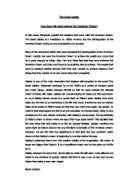The drawbridge in the final paragraph symbolises how it is not easily to get out of the Valley of Ashes, reflecting how it is not easy to get out of a hard life and achieve the American Dream. Myrtle tries hard in the novella to do this, and for a while Gatsby does, which is one reason why we see him as a hero.
Images of how the American Dream has died are shown in the "Valley of Ashes". Ash is symbolic of death, as in "ashes to ashes, dust to dust", a traditional phrase at funerals. In the Valley of Ashes everything is bare, dull, lifeless and dead. It is based on the Corona Dump in Queens, which Fitzgerald famously resented on sight. He also nicknamed the Corona Dump the "Valley of Ashes". 'Of Mice and Men' by John Steinbeck also mentions "ash pile" in the beginning of the novel about the struggle to reach an American Dream. Death is represented by ash later on in the novella when Gatsby is described as "ashen" after his death. He was born in ash and died as ash. His life started as a struggle in a poor area and although he died wealthy, he still died in ash. The dust which "drifts endlessly" could symbolise shards of the American Dream which are helplessly out of reach of the people who live here, but drift in the air to taunt them about what they could become.
The empty valley of ashes reflects the empty lives of the people who live in it. "Occasionally" grey cars enter the "desolate" area, so they made occasional breaks in the emptiness. This is parallel to the empty lives of the inhabitants. Occasionally there is a break and they have visions of hope, such as Myrtle's aspiration to be rich in a life with Tom. This also reflects Gatsby's funeral which was empty apart from Nick and Gatsby's father. Fitzgerald thought of himself as a failure as his writings were not particularly successful during his lifetime, so he may have had himself in mind when describing these lives wih failed hopes and empty dreams.
This passage also gives the impression that morality in the modern world has died. As its place in the novel, the passage is between Nick meeting Tom's wife and Tom's mistress, his situation proves Tom's lack of morals. The passage is the no-mans land between the two women. Nick, the only character proved to have morals in the novella, is introduced to the "eyes of Doctor T. J. Eckleburg" on an advertising board. The "blue and gigantic" eyes look down over the Valley of Ashes and this could be interpreted as God watching over his world. This idea is later strengthened when Wilson looks up at him and refers to him directly as God. Eckleburg, however, wears "enormous yellow spectacles" and also his vision is clouded with dust, and as we see God as our 'all-seeing' moral guide, this could symbolise a lack of moral guidance in the jazz age of the 1920's. There is no-one to show people the way. Doctor T. J. Eckleburg is another good example of symbolism in the passage.
Sight is the link between the three paragraphs of this passage. It moves from sight being obscured by ash and dust, to clarity of sight which is implied by how suddenly the narration switches from grey and dull areas to the bright colours blue and yellow on the 'all-seeing' symbol of T. J. Eckleburg, to train passegers observing what's going on. These are the three ways that Fitzgerald wants us to see the characters, from all angles. An example is how we learn about Gatsby and his life becomes clearer to us by the end of the novella.
Life and death are symbolised by T. J. Eckleburg and ash in this passage and they are described intertwined so as to make it impossible to work out where one ends and another begins. However, mostly this passage is mostly about death: the death of morality, the American Dream and the death of hope. Without these three things, the lives of the people in the area were totally meaningless. Tony Tanners' quote about how the narrator respnds reflects the readers response to this realisation.
"Nick cannot tolerate the thought of confronting a reality that is merely poor and bare, dust-covered and wrecked. There must be more than that."







